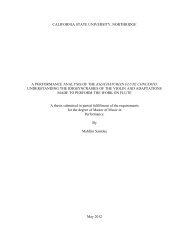2644 - CSUN ScholarWorks - California State University, Northridge
2644 - CSUN ScholarWorks - California State University, Northridge
2644 - CSUN ScholarWorks - California State University, Northridge
You also want an ePaper? Increase the reach of your titles
YUMPU automatically turns print PDFs into web optimized ePapers that Google loves.
76 · Journal of Student Research Abstracts<br />
2813<br />
THE EFFECTS OF WAVELENGTHS ON PLANT GROWTH.<br />
Elaine M. Wong and Steve DeGusta (teacher). John F. Kennedy High School, 6715 Gloria Drive,<br />
Sacramento, CA 95831.<br />
The purpose of this experiment was to determine if the Gymnospermae (pea plants) grown under white light<br />
would attain greater heights in comparison to those grown under red or blue light. I believed that<br />
Gymnospermae would grow best under white light because they would benefit from both the effective red and<br />
blue wavelengths. I grew a group of ten Gymnospermae under white light, red light, and blue light. I grew these<br />
plants in an enclosed chamber to reduce variables such as temperature. I created red and blue lights by covering<br />
a light bulb with a sheet of red cellophane and by covering another bulb with a sheet of blue cellophane. I<br />
found that white light did not produce a significant increase (chi square test: p>0.1) in the heights of the plants<br />
grown under white light. The minor difference in these heights was due to chance alone. I performed a second<br />
experiment to check the results of my first experiment. I once again found that white light did not produce a<br />
significant increase in the heights of the plants. While the three groups of Gymnospermae attained similar<br />
heights, the average height of a plant grown under red light was greater than the average height of a plant under<br />
white or blue light. By performing these investigations, I conclude that plants do not grow significantly better<br />
under white light; plants grown under red or blue light are not deprived of effective wavelengths. While white<br />
light benefits from both red and blue wavelengths, red or blue light benefits from a concentrated amount of a<br />
single effective wavelength.<br />
2814<br />
THE EFFECTS OF AMINO ACIDS ON PEA PlANT GROWTH.<br />
Jared Ahmad Lee and Steve DeGusta (teacher). John F. Kennedy High School, 6715 Gloria Drive,<br />
Sacramento, CA 95831.<br />
In this investigation I tested whether the addition of arginine to a plant's water supply would precipitate a<br />
significant increase in the height of wando pea plants. I planted a total of 24 plants (12 experimental, 12 control)<br />
in potting soil. Unfortunately, eight of the plants never sprouted and one plant eventually died, so I was<br />
left with a sample size of seven experimental plants and eight control plants. I grew the plants for 21 days and<br />
measured them daily. I gave the control-group plants 2.5-ml of water per day, and the experimental group<br />
received 2.5 ml of water with a concentration of 500 mg per liter of arginine. The experimental plants seemed<br />
to be taller, thicker, and leafier than the control plants. It turned out that there was a significant difference<br />
between the two groups of plants (t=3.4, p













